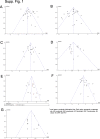Crucial laboratory parameters in COVID-19 diagnosis and prognosis: An updated meta-analysis
- PMID: 32586670
- PMCID: PMC7274591
- DOI: 10.1016/j.medcli.2020.05.017
Crucial laboratory parameters in COVID-19 diagnosis and prognosis: An updated meta-analysis
Abstract
Introduction and objectives: Common laboratory parameters are crucial in aiding coronavirus disease 2019 (COVID-19) case detection. This study aimed to determine the differences between laboratory parameters in (1) COVID-19 versus non-COVID-19 pneumonia, and (2) severe versus non-severe COVID-19 cases.
Methods: Studies were collected until March 2020, and retrieved parameters include leukocyte, neutrophil, thrombocyte, and lymphocyte counts in addition to C-reactive protein (CRP), procalcitonin (PCT) and D-dimer levels. In the presence of heterogeneity, the random-effect model (REM) was used instead of the fixed-effect model (FEM).
Results: Seven studies in the first analysis showed significantly lower leukocyte, neutrophil and platelet counts in COVID-19 pneumonia (SMD=-0.42, 95%CI -0.60 to -0.25, p<0.00001, SMD=-0.23, 95%CI -0.41 to -0.06, p=0.01, SMD=-0.54, 95%CI -0.91 to -0.16, p=0.0005) compared to non-COVID-19 pneumonia. Twenty-six studies in the second analysis showed significantly lower lymphocyte and thrombocyte counts (SMD=-0.56, 95%CI -0.71 to -0.40, p<0.0001, SMD=-0.32, 95%CI -0.49 to -0.15, p=0.0002) and significantly higher leukocyte, neutrophil, D-dimer, and CRP (SMD=0.31, 95%CI 0.07-0.56, p=0.01; SMD=0.44, 95%CI 0.24-0.64, p<0.0001; SMD=0.53, 95%CI 0.31-0.75, p<0.00001; SMD=0.97, 95%CI 0.70-1.24, p<0.00001) in severe COVID-19 compared to non-severe COVID-19.
Conclusions: In conclusion, thrombocyte count is key in both diagnosis and prognosis. Low leukocyte and neutrophil counts are markers of COVID-19 infection, but contrastingly higher counts indicate progressive COVID-19. And although lymphocyte, D-dimer and CRP levels did not demonstrate diagnostic value, all indicate severity of COVID-19. Confirmation of these findings should be performed in future studies.
Introducción y objetivos: Los parámetros comunes de laboratorio son cruciales para ayudar a la detección de casos de enfermedad por coronavirus 2019 (COVID-19). Este estudio tuvo como objetivo determinar las diferencias entre los parámetros de laboratorio en: 1) COVID-19 versus neumonía no COVID-19, y 2) Casos severos versus no severos de COVID-19.
Métodos: Los estudios se recolectaron hasta marzo de 2020, y los parámetros recuperados incluyen recuentos de leucocitos, neutrófilos, trombocitos y linfocitos además de los niveles de proteína C reactiva (PCR), procalcitonina (PCT) y dímero-D. En presencia de heterogeneidad, se utilizó el modelo de efectos aleatorios en lugar del modelo de efectos fijos.
Resultados: Siete estudios en el primer análisis mostraron recuentos de leucocitos, neutrófilos y plaquetas significativamente más bajos en la neumonía por COVID-19 (SMD = −0,42; IC 95%: −0,60 a −0,25; p < 0,00001; SMD = −0,23; IC 95%: −0,41 a −0,06; p = 0,01; SMD = −0,54; IC 95%: −0,91 a −0,16; p = 0,0005) en comparación con la neumonía no COVID-19. Veintiséis estudios en el segundo análisis mostraron recuentos de linfocitos y trombocitos significativamente más bajos (SMD = −0,56; IC 95%: −0,71 a −0,40; p < 0,0001; SMD = −0,32; IC 95%: −0,49 a −0,15; p = 0,0002) y leucocitos, neutrófilos, dímero D y PCR significativamente más altos (SMD = 0,31; IC 95%: 0,07-0,56; p = 0,01; SMD = 0,44; IC 95%: 0,24-0,64; p < 0,0001; SMD = 0,53; IC 95%: 0,31-0,75; p < 0,00001; SMD = 0,97; IC 95%: 0,70-1,24; p < 0,00001) en COVID-19 severo en comparación con COVID-19 no severo.
Conclusiones: En conclusión, el recuento de trombocitos es clave tanto en el diagnóstico como en el pronóstico. Los recuentos bajos de leucocitos y neutrófilos son marcadores de infección por COVID-19, pero los recuentos contrastantemente más altos indican COVID-19 progresivo. Y aunque los niveles de linfocitos, dímero D y PCR no mostraron valor diagnóstico, todos indican la gravedad de COVID-19. La confirmación de estos hallazgos debe realizarse en futuros estudios.
Keywords: COVID-19; Diagnosis; Diagnóstico; Laboratory parameters; Parámetros de laboratorio; SARS-CoV-2.
Copyright © 2020 Elsevier España, S.L.U. All rights reserved.
Figures







References
-
- World Health Organization . 2020. Coronavirus disease 2019 (COVID-19): situation report, vol. 75.
-
- Lloyd-Sherlock P., Ebrahim S., Geffen L., McKee M. Bearing the brunt of covid-19: older people in low and middle income countries. Br Med J Publish Group. 2020 - PubMed
Publication types
MeSH terms
Substances
LinkOut - more resources
Full Text Sources
Research Materials
Miscellaneous

